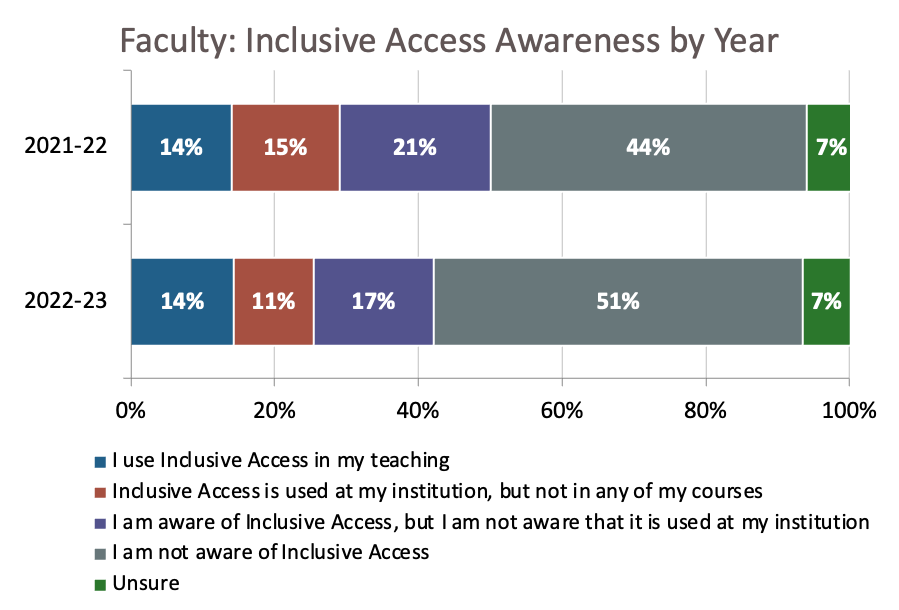You have /5 articles left.
Sign up for a free account or log in.

Awareness of open educational resources has increased in 2023, along with usage, according to a new report.
Getty Images
As the shift toward a more digital classroom continues post-pandemic, faculty members and students alike are finding themselves more aware of and reliant on open educational resources.
Bay View Analytics, with support from the William and Flora Hewlett Foundation, conducts an annual survey focused on open educational resources, or OER. They are teaching and learning materials that are openly licensed, adaptable and freely available online. This year's survey found that both usage and awareness of OER are at an all-time high, with nearly a third of instructors, 29 percent, requiring OER in their classrooms. (Note: The headline on this article has been updated to remove a reference to perceived efficacy of OER.)
There was also a high awareness of OER, with 72 percent of faculty members stating they were “aware” or “very aware” of the resources. Only 15 percent of faculty members said they were unfamiliar with OER.
Julia Seaman and Jeff Seaman, who led the survey for Bay View Analytics, said there was not one singular factor in the rising levels of awareness or usage. Instead, it was a mix of factors, including OER offering more affordable course materials and professors becoming more familiar and comfortable with searching for and using online resources.
“We had this crazy thing with the pandemic where there was a switch to emergency remote [learning], and now everything is a whole lot more online,” Jeff Seaman said. “The surprising part, to me, is the complete linear trend for awareness. It never dipped. The OER message is not being driven by temporal things; it’s a fundamental attraction of the idea of OER among academics.”
There was also a difference in response when Bay View asked professors about the resources with a stricter definition. When asked about their aware of how OER is licensed, only 54 percent said they were “aware” or “very aware,” due to respondents’ relative lack of familiarity with Creative Commons licensing.
The survey spanned 3,000 respondents—with a majority being faculty and roughly 640 administrators—across 50 states and was conducted in April.
Trust in Textbooks Remains High
Textbooks are the most used course material in higher education. According to the survey, more than three out of four faculty members required a physical or digital textbook for their course, as opposed to other online materials such as videos.
“Textbooks are still in the majority of use, but they have been decreasing over the last decade slowly,” Julia Seaman said. “It’s less reliant—there’s a much greater market and freedom of digital tools, like videos and interactive options.”
More than 70 percent of courses that required a textbook made it available in both digital and print formats, the survey found, up from 50 percent in the 2021–22 academic year. The preference for digital only, however, has slipped over the last year. In 2022, 31 percent of faculty members required a digital-only textbook; that dipped to 17 percent in the 2023 academic year.

A 2023 study from Bay View Analytics shows faculty prefer physical textbooks over digital materials.
Bay View Analytics
While faculty members and administrators expressed a personal preference for printed materials over digital formats, they acknowledged digital formats offered more flexibility for students. That sentiment has remained steady over the last year. In the 2022–23 academic year, 73 percent of faculty and administrators “agreed” or “strongly agreed” on the flexibility digital formats provide students, on par with 74 percent that agreed or strongly agreed in the 2021–22 year.
Despite the acknowledged flexibility, almost one-third of administrators believe students learn better from print materials, and more than 40 percent of instructors agreed. Both administrators and faculty also mentioned that physical textbooks help ease digital distractions and that some students—especially those in rural and lower-socioeconomic settings—could have issues with accessing digital tools once they are not on campus, due to connectivity issues.
The two groups are largely ambivalent on the textbook-versus-digital debate, with nearly half of administrators and 44 percent of faculty members stating they neither agree nor disagree that paper textbooks are better for learning.
Confusion Around Inclusive Access
The term “inclusive access” refers to publishers using a subscription model to give every student in a course digital access to a textbook. More than half of respondents stated they did not know what inclusive access was, up from 44 percent of respondents that did not know about inclusive access during the 2021–22 academic year.
Administrators were slightly more aware of the offering, with 43 percent stating they were unfamiliar with inclusive access and nearly a quarter of administrators stating that inclusive access is used at their institution.

A Bay View Advisors 2023 survey showcases faculty have become more unaware of inclusive access over the last academic year.
Bay View Advisors
The percentage of faculty members utilizing inclusive access remained steady, at 14 percent in both the 2021–22 and 2022–23 academic years.
The report’s authors speculated that the lack of knowledge around inclusive access could be due to a lack of a one-stop shop for inclusive access and each iteration having its own unique name.
Uptick of Awareness in the Future
Both Jeff and Julia Seaman said they expect the rate of awareness to eventually flatten for OER; “there’s always going to be some faculty that are clueless,” Julia Seaman said, “whether it is because they are new or simply focused on a physical-first approach.”
But both Seamans expect usage to continue to increase, with them citing a bump in positive attitudes regarding digital tools.
“Even with reverting courses to back in person, they’re still overwhelmingly in favor of online delivery than pre-pandemic levels,” Jeff Seaman said. “There’s a greater willingness than three to four years ago.”
There’s still some footing to be found in the world of digital tools. Julia Seaman pointed toward the large number of digital education start-ups that have yet to get a foothold in the mainstream academic world.
“We think it’s coming, but nothing’s found its growth yet,” she said. “Some faculty are early adopters, but it hasn’t quite spread yet.”







.png?itok=rRo53ZFC)

